Which Of The Following Statements Is True Regarding Filtering Packets In Wireshark?
What Is Wireshark and How Is Information technology Used?
 Few tools are as useful to the IT professional as Wireshark, the get-to network packet capture tool. Wireshark will help you capture network packets and display them at a granular level. In one case these packets are cleaved down, you can use them for real-time or offline analysis. This tool lets you put your network traffic nether a microscope, then filter and drill downwardly into it, zooming in on the root cause of problems, assisting with network assay and ultimately network security. This complimentary Wireshark tutorial will teach you lot how to capture, translate, filter and audit data packets to finer troubleshoot.
Few tools are as useful to the IT professional as Wireshark, the get-to network packet capture tool. Wireshark will help you capture network packets and display them at a granular level. In one case these packets are cleaved down, you can use them for real-time or offline analysis. This tool lets you put your network traffic nether a microscope, then filter and drill downwardly into it, zooming in on the root cause of problems, assisting with network assay and ultimately network security. This complimentary Wireshark tutorial will teach you lot how to capture, translate, filter and audit data packets to finer troubleshoot.
What Is Wireshark?
Wireshark is a network protocol analyzer, or an application that captures packets from a network connection, such as from your figurer to your home office or the internet. Bundle is the proper noun given to a discrete unit of measurement of data in a typical Ethernet network.
Wireshark is the near often-used package sniffer in the globe. Like any other packet sniffer, Wireshark does three things:
- Packet Capture: Wireshark listens to a network connection in existent time and then grabs entire streams of traffic – quite possibly tens of thousands of packets at a time.
- Filtering: Wireshark is capable of slicing and dicing all of this random alive data using filters. By applying a filter, you can obtain just the data yous need to run across.
- Visualization: Wireshark, similar any expert packet sniffer, allows you to dive correct into the very middle of a network bundle. It too allows you to visualize unabridged conversations and network streams.
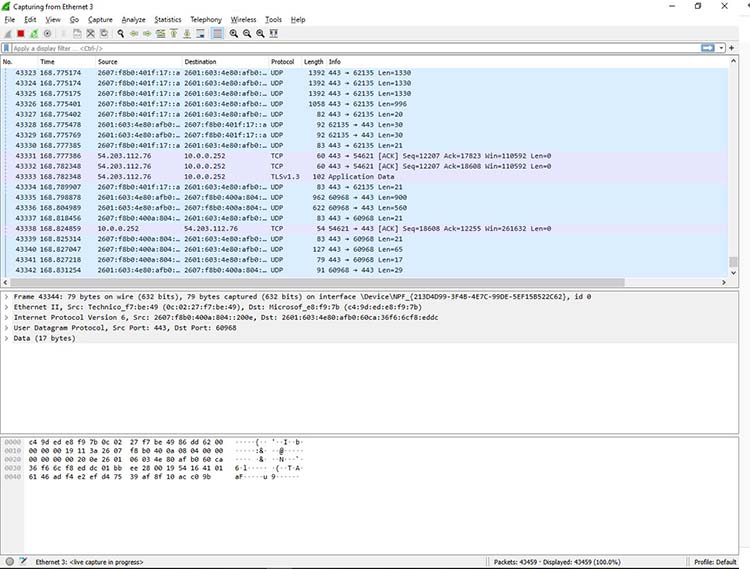
Effigy 1: Viewing a parcel capture in Wireshark
Packet sniffing tin can be compared to spelunking – going within a cave and hiking around. Folks who use Wireshark on a network are kind of like those who utilize flashlights to see what cool things they tin find. After all, when using Wireshark on a network connection (or a flashlight in a cave), you're effectively using a tool to hunt effectually tunnels and tubes to come across what you can see.
What Is Wireshark Used For?
Wireshark has many uses, including troubleshooting networks that accept performance issues. Cybersecurity professionals often use Wireshark to trace connections, view the contents of suspect network transactions and place bursts of network traffic. It's a major function of whatsoever Information technology pro's toolkit – and hopefully, the Information technology pro has the knowledge to utilize it.
When Should Wireshark Be Used?
Wireshark is a condom tool used by regime agencies, educational institutions, corporations, pocket-size businesses and nonprofits alike to troubleshoot network issues. Additionally, Wireshark tin can be used as a learning tool.
Those new to information security can employ Wireshark as a tool to understand network traffic analysis, how communication takes place when item protocols are involved and where information technology goes wrong when certain issues occur.
Of class, Wireshark can't do everything.
Commencement of all, information technology can't help a user who has little understanding of network protocols. No tool, no matter how cool, replaces knowledge very well. In other words, to properly apply Wireshark, you need to learn exactly how a network operates. That means, yous demand to empathise things such every bit the three-mode TCP handshake and various protocols, including TCP, UDP, DHCP and ICMP.
2nd, Wireshark can't catch traffic from all of the other systems on the network nether normal circumstances. On modern networks that apply devices chosen switches, Wireshark (or whatsoever other standard packet-capturing tool) can only sniff traffic between your local reckoner and the remote organization it is talking to.
Third, while Wireshark tin can testify malformed packets and apply colour coding, it doesn't take bodily alerts; Wireshark isn't an intrusion detection system (IDS).
Fourth, Wireshark can't help with decryption with regards to encrypted traffic.
And finally, information technology is quite easy to spoof IPv4 packets. Wireshark tin't actually tell you if a item IP address information technology finds in a captured packet is a existent i or not. That requires a chip more know-how on the part of an IT pro, besides every bit additional software.
Common Wireshark Use Cases
Hither's a common example of how a Wireshark capture tin can assist in identifying a trouble. The figure beneath shows an issue on a dwelling house network, where the internet connectedness was very slow.
Equally the figure shows, the router thought a common destination was unreachable. This was discovered past drilling downwards into the IPv6 Net Message Control Protocol (ICMP) traffic, which is marked in blackness. In Wireshark, any bundle marked in black is considered to reflect some sort of effect.

Figure two: Drilling down into a packet to place a network problem using Wireshark
In this case, Wireshark helped determine that the router wasn't working properly and couldn't find YouTube very easily. The trouble was resolved by restarting the cablevision modem. Of class, while this particular trouble didn't necessitate using Wireshark, information technology'south kind of cool to authoritatively finalize the issue.
When you accept another expect at the bottom of Figure 2, you can come across that a specific parcel is highlighted. This shows the innards of a TCP packet that is part of a ship layer security (TLS) conversation. This is a great instance of how yous tin can drill down into the captured packet.
Using Wireshark doesn't allow yous to read the encrypted contents of the packet, merely yous can identify the version of TLS the browser and YouTube are using to encrypt things. Interestingly enough, the encryption shifted to TLS version ane.2 during the listening.
Wireshark is often used to identify more than complex network bug. For example, if a network experiences besides many retransmissions, congestion can occur. Past using Wireshark, yous tin identify specific retransmission issues, equally shown beneath in Figure 3.

Figure 3: Viewing packet menstruum statistics using Wireshark to identify retransmissions
By confirming this blazon of event, you tin can then reconfigure the router or switch to speed up traffic.
How to Use Wireshark
You can download Wireshark for free at www.wireshark.org. It's also freely available, as an open source awarding under the GNU General Public License version 2.
How to Install Wireshark on Windows
If you're a Windows operating arrangement user, download the version advisable for your particular version. If you use Windows x, for example, you'd grab the 64-chip Windows installer and follow the magician to install. To install, yous'll need administrator permissions.
How to Install Wireshark on Linux
If yous have a Linux system, y'all'd install Wireshark using the following sequence (notice that you'll need to take root permissions):
$ sudo apt-get install wireshark
$ sudo dpkg-reconfigure wireshark-common
$ sudo usermod -a -Grand wireshark $USER
$ newgrp wireshark
One time you have completed the above steps, you then log out and log dorsum in, and then showtime Wireshark:
$ wireshark &
How to Capture Packets Using Wireshark
One time you've installed Wireshark, you tin start grabbing network traffic. Just remember: To capture any packets, you demand to have proper permissions on your computer to put Wireshark into promiscuous mode.
- In a Windows organisation, this ordinarily means you take administrator access.
- In a Linux system, it normally means that you have root access.
- In the Display Filter window, at the top of the screen
- Past highlighting a packet (or a portion of a packet) and correct-clicking on the packet
As long as you accept the correct permissions, y'all accept several options to actually start the capture. Perhaps the all-time is to select Capture >> Options from the main window. This will bring up the Capture Interfaces window, as shown below in Figure 4.

Figure 4: The Capture Interfaces dialog in Wireshark
This window volition listing all available interfaces. In this case, Wireshark provides several to choose from.
For this case, we'll select the Ethernet three interface, which is the virtually active interface. Wireshark visualizes the traffic by showing a moving line, which represents the packets on the network.
Once the network interface is selected, you simply click the Offset button to brainstorm your capture. As the capture begins, it's possible to view the packets that appear on the screen, as shown in Figure v, below.

Effigy 5: Wireshark capturing packets
One time you have captured all the packets that yous want, simply click the red, foursquare button at the pinnacle. Now you take a static packet capture to investigate.
What the Colour Coding Means in Wireshark
Now that y'all have some packets, information technology's time to figure out what they hateful. Wireshark tries to help yous place packet types by applying mutual-sense color coding. The table below describes the default colors given to major parcel types.
| Color in Wireshark | Packet Blazon |
|---|---|
| Lite purple | TCP |
| Low-cal blue | UDP |
| Blackness | Packets with errors |
| Light green | HTTP traffic |
| Light yellow | Windows-specific traffic, including Server Message Blocks (SMB) and NetBIOS |
| Dark yellowish | Routing |
| Dark gray | TCP SYN, FIN and ACK traffic |
The default coloring scheme is shown beneath in Figure half-dozen. You can view this by going to View >> Coloring Rules.
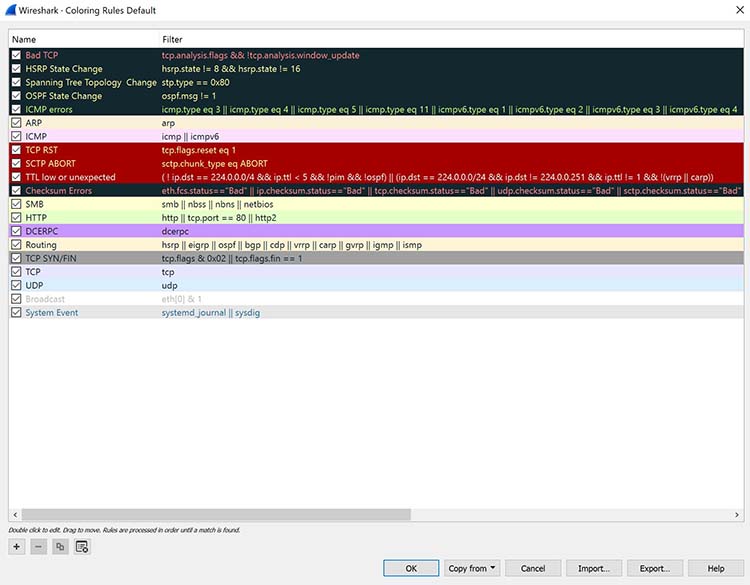
Figure 6: Default coloring rules
You tin can even change the defaults or use a custom dominion. If you don't want any coloring at all, become to View, so click Colorize Packet List. It's a toggle, and then if you want the coloring back, merely go dorsum and click Colorize Package List over again. It'due south possible, fifty-fifty, to colorize specific conversations between computers.
In Figure 7 beneath, you can see standard UDP (light blue), TCP (light purple), TCP handshake (dark grayness) and routing traffic (yellow).

Effigy seven: Viewing colorized packets in Wireshark
Withal, yous're not limited to just interpreting past color. Information technology'due south possible to view the input/output (I/O) statistics of an entire packet capture.
In Wireshark, just go to Statistics >> I/O Graph, and y'all'll meet a graph similar to the i shown in Figure eight.
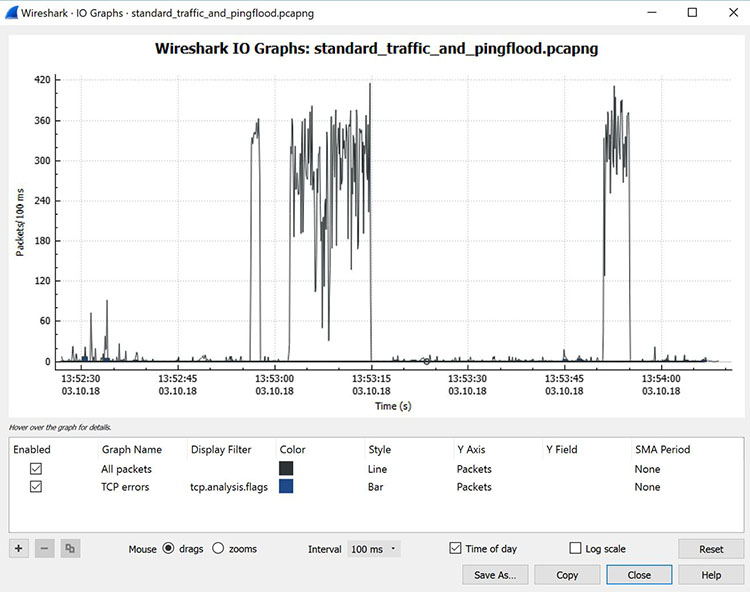
Effigy eight: Viewing the input/output traffic graph in Wireshark
This particular graph is showing typical traffic generated by a domicile office. The spikes in the graph are bursts of traffic that were caused past generating a Distributed Deprival of Service (DDoS) attack using a few Linux systems.
In this example, three major traffic bursts were generated. Many times, cybersecurity pros use Wireshark equally a quick and dirty way to identify traffic bursts during attacks.
It's also possible to capture the amount of traffic generated between one arrangement and another. If you go to Statistics and so select Conversations, you lot will see a summary of conversations betwixt end points, every bit shown beneath in Figure ix.

Figure ix: Viewing endpoint conversations in Wireshark
In the above case, Wireshark was used to run into if an old piece of equipment from MCI communications that was running on a client's network could be traced.
It turned out that the client didn't know this device was even on the network. Thus, information technology was removed, helping to make the network a scrap more secure. Discover, also, that this network connection is experiencing a lot of traffic to Amazon (administering a server in AWS at the fourth dimension) and Box.com (using Box for system backup at the fourth dimension).
In some cases, it is fifty-fifty possible to apply Wireshark to identify the geographic location of source and destination traffic. If y'all click on the Map button at the bottom of the screen (shown in Effigy ix above), Wireshark will bear witness yous a map (Figure x), providing its all-time judge of the location of the IP addresses you lot've identified.

Figure ten: Viewing geographic estimations in Wireshark
Because IPv4 addresses can be easily spoofed, you can't rely completely on this geographical information. Simply it can be fairly authentic.
How to Filter and Audit Packets in Wireshark
You lot tin can utilize Wireshark filters in two means:
Wireshark filters use primal phrases, such as the following:
| ip.addr | Specifies an IPv4 address |
| ipv6.addr | Specifies an IPv6 address |
| src | Source - where the package came from |
| dst | Destination - where the packet is going |
You can also utilize the following values:
| && | Means "and," equally in, "Choose the IP address of 192.168.2.1 and 192.168.2.2" |
| == | Means "equals," as in "Cull only IP address 192.168.two.ane" |
| ! | Means "non," as in, do not bear witness a detail IP address or source port |
Valid filter rules are always colored light-green. If you brand a mistake on a filter rule, the box will turn a brilliant pink.
Let's start with a couple of basic rules. For instance, let'south say y'all want to see packets that have only the IP address of 18.224.161.65 somewhere inside. You would create the post-obit control line, and put it into the Filter window:
ip.addr == 18.224.161.65
Figure 11 shows the results of adding that filter:
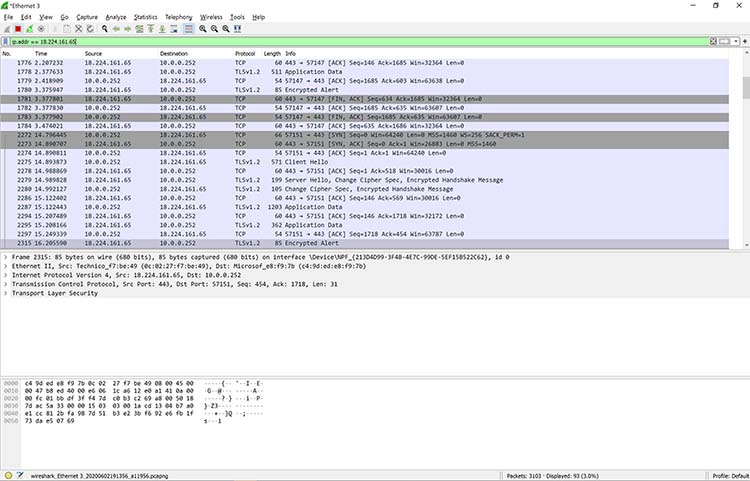
Figure 11: Applying a filter to a capture in Wireshark
Alternatively, yous can highlight the IP address of a packet then create a filter for it. Once you select the IP address, correct-click, then select the Apply As Filter option.
You'll so run into a bill of fare of boosted options. Ane of those is called Selected. If you lot choose Selected, then Wireshark volition create a filter that shows merely packets with that IP accost in it.
You tin too determine to filter out a specific IP address using the post-obit filter, likewise shown in Figure 12:
!ip.addr==18.224.161.65
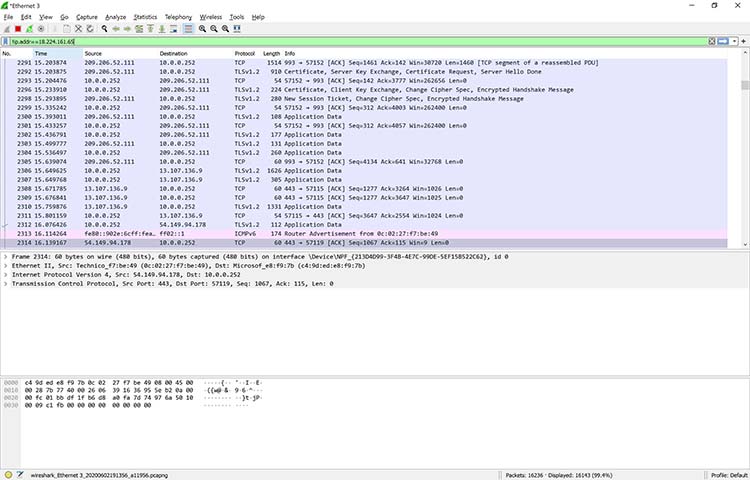
Figure 12: Filtering out a specific IP accost in Wireshark
Yous're not limited to only IPv4 addresses. For case, if y'all want to see if a detail computer is agile and using an IPv6 address on your network, you lot tin open upwards a copy of Wireshark and utilize the following rule:
ipv6.dst == 2607:f8b0:400a:15::b
This same rule is shown in Effigy 13.
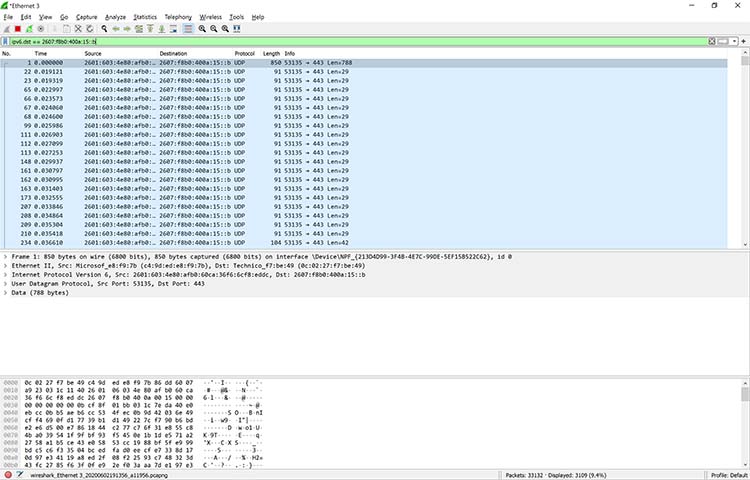
Figure thirteen: Applying an IPv6 filter in Wireshark
Clearly, this system is alive and well, talking on the network. At that place are so many possibilities.
Additional filters include:
| tcp.port==8080 | Filters packets to show a port of your own choosing – in this case, port 8080 |
| !(ip.src == 162.248.sixteen.53) | Shows all packets except those originating from 162.248.xvi.53 |
| !(ipv6.dst == 2607:f8b0:400a:15::b) | Shows all packets except those going to the IPv6 accost of 2607:f8b0:400a:xv::b |
| ip.addr == 192.168.4.one && ip.addr == 192.168.4.ii | Shows both 192.168.4.1 and 192.168.4.2 |
| http.request | Shows just http requests – useful when troubleshooting or visualizing spider web traffic |
As you tin can encounter, Wireshark is a powerful application.
Want to Learn More About Wireshark?
If yous desire to dive a scrap deeper, check out the following 60 minutes-long webinar called Using Wireshark: A Hands-on Demonstration. Information technology'southward available on need – all you demand to do is register, and yous can view the video.
And the table beneath contains links to Wireshark, as well equally actual packet captures that yous can utilize to learn more than. You can fifty-fifty download a quick "cheat sheet" in PDF form from Packetlife.cyberspace.
| Resource | URL |
| Wireshark website | www.wireshark.org |
| Wireshark sample packet captures | https://wiki.wireshark.org/SampleCaptures |
| Packet captures galore, with an emphasis on security | www.malware-traffic-analysis.net |
| Package captures past protocol | https://www.netresec.com/?page=pcapfiles |
| Additional packet captures | http://tcpreplay.appneta.com/wiki/captures.html |
| Wireshark cheat sheet | http://packetlife.net/media/library/13/Wireshark_Display_Filters.pdf |
Read more about Cybersecurity.
Which Of The Following Statements Is True Regarding Filtering Packets In Wireshark?,
Source: https://www.comptia.org/content/articles/what-is-wireshark-and-how-to-use-it
Posted by: nicholsdocklinew.blogspot.com


0 Response to "Which Of The Following Statements Is True Regarding Filtering Packets In Wireshark?"
Post a Comment